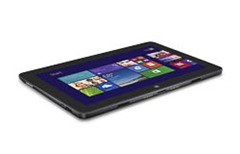The tablet to cure all ills
 Marc Flanagan, Head of Central Government Business in Dell, discusses the increasing use of tablets in organisations and some of the areas and challenges organisations need to be thinking about as they embrace this technology.
Marc Flanagan, Head of Central Government Business in Dell, discusses the increasing use of tablets in organisations and some of the areas and challenges organisations need to be thinking about as they embrace this technology.
The way staff connect to and access data and applications is rapidly changing, brought on by the proliferation of new mobile devices and the blurring of the lines between professional and personal lives. As workforce dynamics continue to evolve, organisations are taking notice and beginning to embrace this new way of working. Organisations want a thriving workforce – one that is creative and efficient – and see an opportunity to provide the technologies that empower workers to ultimately have a positive impact on the organisations performance.
Employees are already experiencing the benefits of current technology in their personal lives and expect their respective organisations to extend these benefits into the workplace. It’s at this intersection of consumer behaviour and business need that the tablet is emerging as a top choice among many organisations, due to its ability to meet a range of computing demands while complementing different work habits and lifestyles.
With the latest developments in technology, tablets are as powerful as laptops and as such we are starting to see a shift in the market. Previously, tablets were a companion or secondary device for senior management and mobile workers to access email and internet while out and about. These users would also have a standard desktop or laptop in addition to the tablet. Now, Windows tablets are available with the same processors and peripherals as laptops and as such we are seeing a shift towards organisations giving mobile staff a powerful tablet with a keyboard and docking station as their only device.
In the Irish market, we are seeing the public sector as one of the innovators in this area. We have a number of departments which are at the advanced stages of completing POCs and one or two which have embraced mobility in a big way and have purchased hundreds of tablet devices as the sole device for their mobile workforce.
While management welcome the productivity-enhancing features of the tablet, IT decision-makers want to make sure any new technology meets the IT organisation’s criteria for cost-efficiency, security, simplified integration, mobile management and easy application deployment. Today’s tablets meet these demands with advanced security features, rugged construction, long battery life, touch capabilities and slim, lightweight designs, as well as full access to Microsoft Office 2013. Tablets can now be managed just like any other device on the network with simple access to enterprise content and legacy applications.
Management of these mobile devices is an absolutely key area that needs to be focused on by IT teams. Dell Enterprise Mobility Management (EMM) is a comprehensive mobile enablement solution built with field-tested, leading-edge security and management technology. It gives IT the ability to provision, manage and secure today’s devices, regardless of who owns them, as well as the flexibility to handle the changes in mobile technology that tomorrow’s technology will inevitably bring.
Dell EMM separates enterprise data and applications from personal data and applications on employees’ mobile devices, so employees can embrace the organisation’s security measures instead of trying to work around them.
While the number and types of devices are proliferating and changing, computer selection is becoming more about the situation, location and occasion. Therefore, choosing the right device requires understanding the different types of user groups within the organisation. These groups can be broken down based on their individual needs and preferences, the type of work these users perform, and whether these workers are primarily mobile or stationary.
Choosing the right device for employees requires an understanding of user needs, preferences, job functions and degree of mobility. At a high level we can categorise users into two main areas: primary devices and companion devices.
The way we interact with a tablet is different from how we interact with a laptop. We are using our finger or a stylus instead of a mouse. The user may be out in the field as opposed to sitting at a desk. Application owners need to be wary of these factors and need to consider the user experience to determine whether applications need to have a tablet-friendly or touch-friendly version as opposed to using the standard version on a tablet device. This type of application development is an area in which Dell specialises, and we have completed a number of these types of engagement in the Irish market, both in the public and private sectors.
As tablets and other mobile devices continue to change the way people work, organisations need to make sure they keep up with these evolving workforce demands. Workplace applications are consistently being developed to make remote and mobile workers more effective with their daily work tasks in the field, enabling small form-factor devices to fit this user group’s needs. How decision-makers respond to these dynamics will shape the next generation of IT and play a key role in an organisation’s success.
1. Primary device (laptop or desktop replacement)
This is where a user is given a high powered tablet as their sole device. This user profile would be someone who spends 75 per cent or more of their time out of the office. They would normally get a detachable keyboard, a docking station and a monitor so that it can be used both as a standard desktop and as a mobile device. The device is used in exactly the same way as a laptop and the user accesses all their normal corporate applications via this device. The Dell Venue Pro 11 is one of the market leaders in this space and we are seeing a significant uptake in this device across the Irish public sector.
2. Companion or secondary device
This is where a user is given a tablet as a secondary device so it is given in addition to having a standard laptop or desktop. The main two requirements we see here are to access email and internet with some limited access to corporate applications. The user still spends the majority of their time in front of a laptop or desktop and this is where they access their main corporate applications. The profile of this user is usually senior management or staff who spend some time out of the office. The smaller Dell Venue Pro 8 is a smaller lighter less powerful option than the Venue 11 which is perfectly suited to this task.
For more information, please contact:
 Marc Flanagan
Marc Flanagan
Head of Central Government Business
Email: Marc_Flanagan@dell.com
Eamon McGlade
Account Manager, Central Government
Email: Eamon_McGlade@dell.com







